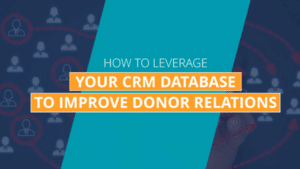
At the heart of your nonprofit are donors who share your vision and want to see your mission succeed. However, to acquire these donors and solidify their long-term support, you need to understand them on a deeper level. That’s where a customer relationship management (CRM) platform comes in.
By leveraging your CRM effectively, you can make data-driven decisions that lead to more significant engagement, increased retention, and fundraising revenue that allows you to fulfill your mission. In this guide, we’ll explore four ways to improve donor relations through your CRM.
Automate Acknowledgement
Acknowledging donors’ gifts in a timely manner shows that you care and can lead to a relationship. To ensure every donor gets thanked, CRM software allows you to set up automated messages that trigger in response to certain milestones and activities, such as:
-
- Donations: Send automated donation receipts to acknowledge financial contributions and provide records for tax purposes. Ensure these receipts include the donor’s name, donation amount, date, and your organization’s tax-exempt information.
- Engagement: If a donor attends an event, signs up to volunteer, or subscribes to your newsletter, trigger follow-up communication to extend your appreciation and invite them to deepen their engagement by exploring the rest of your content.
- Anniversaries or important occasions: Set up an automated email to be sent on the anniversary of a donor’s first contribution or on other special occasions like a birthday. This personal acknowledgment can deepen their commitment to your cause.
- Lapse: When a previously recurring donor reaches one year without giving, trigger a re-engagement email series that includes updates on recent successes, stories of impact, and invitations to upcoming events to reconnect them with your organization.
While automation is efficient, it should also be balanced with personalization. Add your donors’ names, donation amounts, and specifics about their impact wherever applicable in your messages.
Segment and Personalize Outreach
Segmentation is the act of organizing donors into distinct groups based on shared characteristics. Rather than sending the same message to your entire donor list, you can tailor content to each segment’s unique preferences to foster stronger connections, improve engagement, and maximize the impact of your outreach efforts.
Depending on your CRM’s capabilities, create segments using tags, lists, or custom fields. For instance, you could add a custom field to donor profiles for the following giving levels:
- New donors: When someone gives to your organization for the first time, your goal should be to nurture that relationship. Flag new donors so you can focus on sending them a warm welcome to your community and sharing relevant information about your mission and programs to secure a second donation.
- Recurring donors: For your nonprofit to remain stable, you need consistent and reliable funding. When you reach out to recurring donors, emphasize the impact of ongoing support in your communications and offer opportunities for deeper engagement.
- Major donors: Major gifts likely make up the largest portion of your fundraising revenue. Keep detailed donor profiles for current and potential major donors, allowing your major gifts team to focus on creating a personalized engagement, showing these donors the direct impact of their support, and involving them in exclusive events or initiatives.
- Lapsed donors: Although these donors haven’t contributed in a while, you shouldn’t give up on soliciting their support. Track both at-risk and lapsed donors in your CRM, remind them of their previous generosity, share recent successes, and offer opportunities to reconnect.
How you segment donors and personalize communications will vary depending on your needs. For example, when promoting a hybrid event, it would be beneficial to segment supporters based on geographic location, reserving in-person invitations for donors living within a certain radius and virtual invite links for those living outside of it.
Optimize Fundraising Opportunities
Donors are more likely to engage with an organization that understands and respects their preferences. Ensure you are on the same page with your donors by designing your fundraising plan around the trends and patterns housed in your donor database. Look for insights like:
- Optimal donation amounts: Review donation data to understand the range of contribution amounts that you typically receive. This is especially important when determining what a major gift means to your organization. For example, if your average major gift is $50,000, you can conduct prospect research to identify donors who are potentially willing and able to give at or above that amount.
-
- Popular fundraising channels: Identify the fundraising channels that have historically yielded the most donations. Consider optimizing those that are underperforming or allocating their resources to where you are most successful.
- Preferred giving times: Determine when donors are most responsive to your fundraising appeals. Then, schedule your fundraising campaigns and communication for these optimal times to maximize responsiveness. For example, if you notice that a certain group of donors tends to give around the holidays, you can create a holiday-themed campaign to target their engagement.
Certain CRMs come with built-in fundraising capabilities, so you can start analyzing these metrics as soon as you get your CRM set up.
Produce Donor Impact Reports
Donor impact reports are generally sent in response to major gifts or program achievements and are a powerful tool for donor stewardship, as they show a direct correlation between donations and positive outcomes. Maximize the impact of these reports by leveraging the following metrics from your CRM:
Donor history: Include a summary of the donor’s past contributions, showing their donations’ dates, amounts, and the programs they went toward. This will help them visualize their ongoing commitment to your organization’s mission.
- Constituents helped: Highlight the number of constituents who have directly benefited from your nonprofit’s programs to demonstrate how supporters’ donations have a tangible impact.
- Funds utilized: Provide a breakdown of how the funds raised were used, specifying how much went into different projects, initiatives, or operational costs. Transparency in fund allocation builds trust and accountability.
If you’re having trouble compiling this information and translating it into a donor impact report, consider partnering with a nonprofit consulting firm that specializes in technology. Consultants can identify where you need to improve your data collection and management processes to ensure that your reports are accurate and comprehensive.
Leveraging your CRM is the key to securing long-term donor relationships. For the best results, keep your database up-to-date and continually refine your fundraising and marketing strategies based on the insights you gain. With a data-driven approach, you can solidify support for years to come.
 Carl Diesing, Managing Director – Carl co-founded DNL OmniMedia in 2006 and has grown the team to accommodate clients with ongoing web development projects. Together DNL OmniMedia has worked with over 100 organizations to assist them with accomplishing their online goals. As Managing Director of DNL OmniMedia, Carl works with nonprofits and their technology to foster fundraising, create awareness, cure disease, and solve social issues. Carl lives in the Hudson Valley with his wife Sarah and their two children Charlie and Evelyn.
Carl Diesing, Managing Director – Carl co-founded DNL OmniMedia in 2006 and has grown the team to accommodate clients with ongoing web development projects. Together DNL OmniMedia has worked with over 100 organizations to assist them with accomplishing their online goals. As Managing Director of DNL OmniMedia, Carl works with nonprofits and their technology to foster fundraising, create awareness, cure disease, and solve social issues. Carl lives in the Hudson Valley with his wife Sarah and their two children Charlie and Evelyn.
